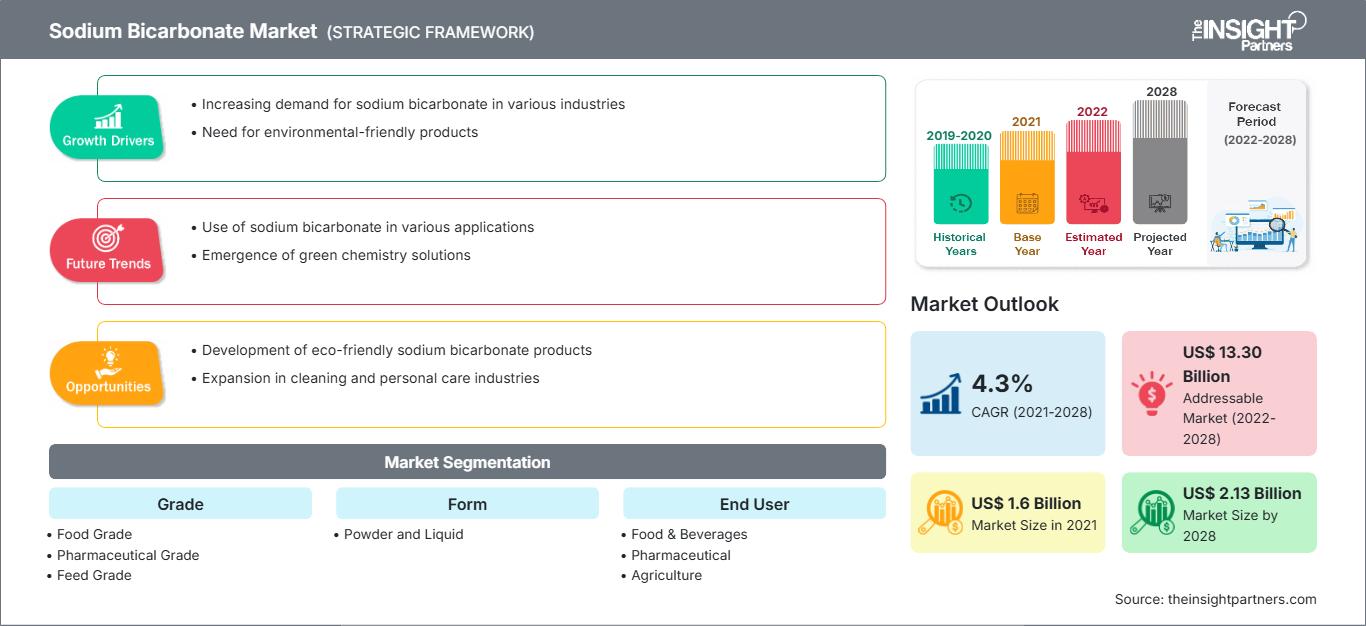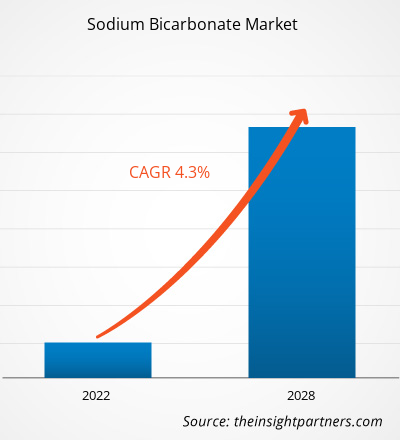[Informe de investigación] Se espera que el mercado de bicarbonato de sodio crezca de US$ 1.596,37 millones en 2021 a US$ 2.133,33 millones en 2028; se espera que crezca a una CAGR del 4,3% de 2021 a 2028.
El bicarbonato de sodio, comúnmente conocido como bicarbonato de sodio, es un compuesto químico de fórmula NaHCO₃. Tiene una amplia gama de aplicaciones. Se utiliza ampliamente en las industrias de alimentos y bebidas, química, farmacéutica, agrícola y cosmética y de cuidado personal.
En 2021, Asia Pacífico registró la mayor participación en los ingresos del mercado mundial de bicarbonato de sodio. El creciente uso de bicarbonato de sodio en diversas aplicaciones, como piensos, productos de panadería, productos de limpieza y cosméticos, impulsa principalmente el crecimiento del mercado en Asia Pacífico. El aumento de la renta disponible se asocia a una mayor demanda de productos de panadería. Además, la mejora de la situación socioeconómica y el desarrollo a gran escala de los sectores digital y manufacturero están generando una alta demanda de productos cosméticos en países como India. La industria cosmética en la región está creciendo a un ritmo acelerado, con un gran número de consumidores comprando productos de belleza y cuidado personal. Por lo tanto, la demanda de bicarbonato de sodio está en aumento, ya que se utiliza en pastas dentales, desodorantes, mascarillas faciales, espumas y geles limpiadores faciales, y polvos cosméticos en la industria cosmética y del cuidado personal.
Obtendrá personalización en cualquier informe, sin cargo, incluidas partes de este informe o análisis a nivel de país, paquete de datos de Excel, así como también grandes ofertas y descuentos para empresas emergentes y universidades.
Mercado del bicarbonato de sodio: perspectivas estratégicas

-
Obtenga las principales tendencias clave del mercado de este informe.Esta muestra GRATUITA incluirá análisis de datos, desde tendencias del mercado hasta estimaciones y pronósticos.
Impacto de la pandemia de COVID-19 en el mercado del bicarbonato de sodio
La pandemia de COVID-19 ha afectado las economías e industrias de varios países debido a confinamientos, prohibiciones de viaje y cierres de negocios. En 2020, diversas industrias tuvieron que reducir sus operaciones debido a las interrupciones en las cadenas de valor causadas por las restricciones en las fronteras nacionales e internacionales. La pandemia alteró los procesos de fabricación y generó interrupciones en la cadena de suministro de materias primas debido a las restricciones impuestas por las autoridades gubernamentales. La pandemia obligó a las personas a permanecer en sus hogares. Aprovechó el tiempo libre para mejorar sus habilidades culinarias. Muchas personas comenzaron a dedicarse a la repostería y la cocina. Esto generó una demanda de diferentes ingredientes de panadería, incluido el bicarbonato de sodio.
Diversas industrias también están superando los desafíos relacionados con las interrupciones en la cadena de suministro de sus materias primas. Por lo tanto, la demanda de bicarbonato de sodio está aumentando en diferentes industrias.
Perspectivas del mercado
Aumento del consumo de alimentos horneados
El bicarbonato de sodio es uno de los ingredientes más utilizados en panadería. Se puede utilizar como agente leudante, regulador de pH y agente efervescente en la industria panadera. El pan, las galletas, los pasteles, las tartas y los pasteles se encuentran entre los productos más comunes en la industria panadera a nivel mundial. El pan es un alimento básico en muchos países europeos. El pan orgánico también está ganando popularidad. En cuanto al pan orgánico, Alemania se está convirtiendo en uno de los mercados más grandes de Europa. Alemania cuenta con una amplia variedad de panes gracias a sus condiciones climáticas, que permiten el cultivo de todo tipo de cereales. La industria panadera en Estados Unidos está bien establecida. Además, la industria de productos horneados en Australia está en crecimiento, ya que los consumidores siguen comprando una amplia variedad de productos alimenticios recién horneados de alta calidad debido al creciente deseo de opciones de alimentos saludables. Por lo tanto, el creciente consumo de alimentos horneados está impulsando el mercado mundial del bicarbonato de sodio.
Perspectivas de calificación
Según el grado, el mercado global de bicarbonato de sodio se segmenta en grado alimenticio, grado farmacéutico, grado para piensos, grado técnico y otros. El segmento de grado técnico y otros tuvo la mayor participación en el mercado global de bicarbonato de sodio en 2021. El bicarbonato de sodio de grado técnico se utiliza comúnmente para fines comerciales e industriales. Se utiliza en diversas aplicaciones, como síntesis química, tintes, cuero, extintores, tratamiento de agua y aguas residuales, moldeo de plásticos, cerámica, textiles, desulfuración de gases residuales y producción de papel.desulphurization, and paper production.
Información del usuario final
Según el usuario final, el mercado global del bicarbonato de sodio se segmenta en alimentos y bebidas, productos farmacéuticos, agricultura, productos químicos, cosméticos y cuidado personal, textiles y cuero, cuidado del hogar, entre otros. El segmento de alimentos y bebidas tuvo la mayor participación en el mercado global de bicarbonato de sodio en 2021. El bicarbonato de sodio es un ingrediente esencial en la industria de alimentos y bebidas. Es un valioso amortiguador y neutralizador en bebidas. En varios refrescos, el bicarbonato de sodio se utiliza como fuente de CO₂.
Solvay SA; Tosoh Corporation; Burwell Technologies; All Chemical Manufacturing & Consultancy Pty Ltd; Pon Pure Chemicals Group; Church & Dwight, Inc.; Sişecam; AGC Inc.; Ciech SA; y GHCL Limited son algunas de las principales empresas que operan en el mercado global del bicarbonato de sodio. Los actores del mercado se centran en ofrecer productos de alta calidad para satisfacer la demanda de los clientes.
Informe destacado
- Tendencias progresivas de la industria en el mercado del bicarbonato de sodio para ayudar a los actores a desarrollar estrategias efectivas a largo plazo.
- Estrategias de crecimiento empresarial adoptadas por los mercados desarrollados y en desarrollo
- Análisis cuantitativo del mercado de bicarbonato de sodio de 2020 a 2028
- Estimación de la demanda mundial de bicarbonato de sodio
- Análisis de las cinco fuerzas de Porter para ilustrar la eficacia de los compradores y proveedores que operan en la industria
- Desarrollos recientes para comprender el escenario del mercado competitivo
- Tendencias y perspectivas del mercado, así como factores que impulsan y restringen el crecimiento del mercado del bicarbonato de sodio.
- Asistencia en el proceso de toma de decisiones destacando las estrategias de mercado que sustentan el interés comercial, lo que conduce al crecimiento del mercado.
- El tamaño del mercado de bicarbonato de sodio en varios nodos
- Descripción detallada y segmentación del mercado, así como la dinámica de la industria del bicarbonato de sodio.
- Tamaño del mercado de bicarbonato de sodio en diversas regiones con prometedoras oportunidades de crecimiento
Perspectivas regionales del mercado del bicarbonato de sodio
Los analistas de The Insight Partners han explicado detalladamente las tendencias regionales y los factores que influyen en el mercado del bicarbonato de sodio durante el período de pronóstico. Esta sección también analiza los segmentos y la geografía del mercado del bicarbonato de sodio en América del Norte, Europa, Asia Pacífico, Oriente Medio y África, y América del Sur y Central.
Alcance del informe de mercado de bicarbonato de sodio
| Atributo del informe | Detalles |
|---|---|
| Tamaño del mercado en 2021 | 1.600 millones de dólares estadounidenses |
| Tamaño del mercado en 2028 | US$ 2.13 mil millones |
| CAGR global (2021-2028) | 4,3% |
| Datos históricos | 2019-2020 |
| Período de pronóstico | 2022-2028 |
| Segmentos cubiertos |
Por grado
|
| Regiones y países cubiertos |
América del norte
|
| Líderes del mercado y perfiles de empresas clave |
|
Densidad de actores del mercado de bicarbonato de sodio: comprensión de su impacto en la dinámica empresarial
El mercado del bicarbonato de sodio está creciendo rápidamente, impulsado por la creciente demanda del usuario final debido a factores como la evolución de las preferencias de los consumidores, los avances tecnológicos y un mayor conocimiento de los beneficios del producto. A medida que aumenta la demanda, las empresas amplían su oferta, innovan para satisfacer las necesidades de los consumidores y aprovechan las tendencias emergentes, lo que impulsa aún más el crecimiento del mercado.

- Obtenga una descripción general de los principales actores clave del mercado de bicarbonato de sodio
Mercado mundial de bicarbonato de sodio, por grado
- Grado alimenticio
- Grado farmacéutico
- Grado de alimentación
- Grado Técnico y Otros
Mercado mundial de bicarbonato de sodio, por formato
- Polvo
- Líquido
Mercado mundial de bicarbonato de sodio, por usuario final
- Alimentos y bebidas
- Farmacéutico
- Agricultura
- Químico
- Cosméticos y cuidado personal
- Textil y cuero
- Cuidado domiciliario
- Otros
Perfiles de empresas
- Solvay SA
- Corporación Tosoh
- Tecnologías Burwell
- All Chemical Manufacturing & Consultancy Pty Ltd
- Grupo de productos químicos puros Pon
- Iglesia y Dwight, Inc.
- Sisecam
- AGC Inc.
- Ciech SA
- GHCL Limitada
- Análisis histórico (2 años), año base, pronóstico (7 años) con CAGR
- Análisis PEST y FODA
- Tamaño del mercado, valor/volumen: global, regional y nacional
- Industria y panorama competitivo
- Conjunto de datos de Excel
Informes recientes
Testimonios
Razón para comprar
- Toma de decisiones informada
- Comprensión de la dinámica del mercado
- Análisis competitivo
- Información sobre clientes
- Pronósticos del mercado
- Mitigación de riesgos
- Planificación estratégica
- Justificación de la inversión
- Identificación de mercados emergentes
- Mejora de las estrategias de marketing
- Impulso de la eficiencia operativa
- Alineación con las tendencias regulatorias






















 Obtenga una muestra gratuita para - Mercado de bicarbonato de sodio
Obtenga una muestra gratuita para - Mercado de bicarbonato de sodio